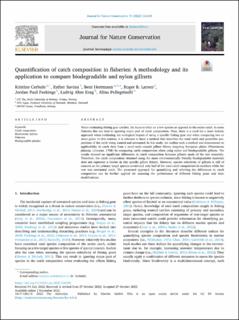| dc.contributor.author | Cerbule, Kristine | |
| dc.contributor.author | Savina, Esther | |
| dc.contributor.author | Herrmann, Bent | |
| dc.contributor.author | Larsen, Roger B. | |
| dc.contributor.author | Feekings, Jordan Paul | |
| dc.contributor.author | Krag, Ludvig Ahm | |
| dc.contributor.author | Pellegrinelli, Alina | |
| dc.date.accessioned | 2022-11-18T11:06:23Z | |
| dc.date.available | 2022-11-18T11:06:23Z | |
| dc.date.created | 2022-11-14T15:48:54Z | |
| dc.date.issued | 2022 | |
| dc.identifier.citation | Journal for Nature Conservation. 2022, 70 1-10. | en_US |
| dc.identifier.issn | 1617-1381 | |
| dc.identifier.uri | https://hdl.handle.net/11250/3032831 | |
| dc.description.abstract | When evaluating fishing gear catches, the focus is often on a few species as opposed to the entire catch. In some fisheries this can lead to ignoring major part of catch composition. Thus, there is a need for a more holistic approach when evaluating the ecological impact of using a specific fishing gear and when comparing two or more gears. In this context, it is relevant to have a method that describes the total catch and quantifies proportions of the catch being wanted and unwanted. In this study, we outline such a method and demonstrate its applicability to catch data from a small-scale coastal gillnet fishery targeting European plaice (Pleuronectes platessa, Linnaeus, 1758) by comparing catch composition when using nylon and biodegradable gillnets. The results showed no significant differences in catch composition between gillnets made of the two materials. Therefore, the catch composition obtained using the more environmentally friendly biodegradable materials does not represent a barrier in this specific gillnet fishery. However, species selectivity of gillnets is still of concern as the primary target species constituted only half of the total catch composition in numbers while the rest was unwanted catch. The presented approach for quantifying and inferring the differences in catch composition can be further applied for assessing the performance of different fishing gears and their modifications. | en_US |
| dc.language.iso | eng | en_US |
| dc.publisher | Elsevier | en_US |
| dc.rights | Navngivelse 4.0 Internasjonal | * |
| dc.rights | Navngivelse 4.0 Internasjonal | * |
| dc.rights.uri | http://creativecommons.org/licenses/by/4.0/deed.no | * |
| dc.subject | Biodegradable plastics | en_US |
| dc.subject | Fisheries | en_US |
| dc.subject | Biodiversity indices | en_US |
| dc.subject | Catch composition | en_US |
| dc.title | Quantification of catch composition in fisheries: A methodology and its application to compare biodegradable and nylon gillnets | en_US |
| dc.title.alternative | Quantification of catch composition in fisheries: A methodology and its application to compare biodegradable and nylon gillnets | en_US |
| dc.type | Peer reviewed | en_US |
| dc.type | Journal article | en_US |
| dc.description.version | publishedVersion | en_US |
| dc.rights.holder | © 2022 The Author(s). Published by Elsevier GmbH | en_US |
| dc.source.pagenumber | 1-10 | en_US |
| dc.source.volume | 70 | en_US |
| dc.source.journal | Journal for Nature Conservation | en_US |
| dc.identifier.doi | 10.1016/j.jnc.2022.126298 | |
| dc.identifier.cristin | 2073735 | |
| dc.relation.project | Norges forskningsråd: 300008 | en_US |
| dc.source.articlenumber | 126298 | en_US |
| cristin.ispublished | true | |
| cristin.fulltext | original | |
| cristin.qualitycode | 1 | |

